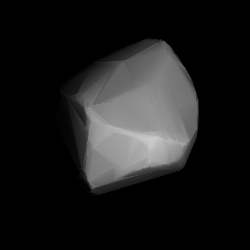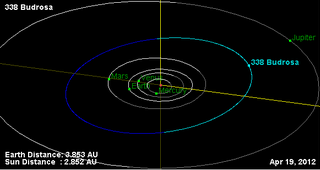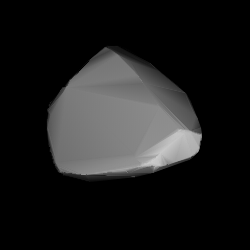
199 Byblis is a medium-sized main belt asteroid.

Coelestina is a typical main belt asteroid.

Budrosa is a large Main belt asteroid. It is classified as an M-type asteroid. It was discovered by Auguste Charlois on 25 September 1892 in Nice.

343 Ostara is a background asteroid from the inner region of the asteroid belt. It was discovered by German astronomer Max Wolf at the Heidelberg Observatory on 15 November 1892.

394 Arduina is an asteroid from the central regions of the asteroid belt. It was discovered by A. Borrelly on 19 November 1894 in Marseilles.

Nassovia is a minor planet orbiting the Sun. It is a member of the Koronis family of asteroids.

621 Werdandi is a Themistian asteroid.
623 Chimaera is a minor planet, specifically an asteroid orbiting in the asteroid belt.
625 Xenia is a minor planet orbiting the Sun. It was discovered by August Kopff in Heidelberg, Germany, on 11 February 1907. The name may have been inspired by the asteroid's provisional designation 1907 XN.

662 Newtonia is a minor planet, specifically an asteroid orbiting mostly in the asteroid belt.
668 Dora is an asteroid orbiting in the asteroid belt located roughly between the orbits of the planets Mars and Jupiter. The name may have been inspired by the asteroid's provisional designation 1908 DO.
768 Struveana is a minor planet orbiting the Sun. The asteroid was named jointly in honor of Baltic German astronomers Friedrich Georg Wilhelm von Struve, Otto Wilhelm von Struve and Karl Hermann Struve.
818 Kapteynia is a minor planet orbiting the Sun. This asteroid is named for the Dutch astronomer Jacobus Kapteyn.

852 Wladilena is a Phocaea asteroid from the inner region of the asteroid belt. It is named after the Russian Communist leader Vladimir Lenin.
872 Holda is a minor planet orbiting the Sun.
895 Helio is a large dark outer main-belt asteroid about 150 km in diameter. It was discovered on 11 July 1918 by German astronomer Max Wolf. It is named after the element helium, whose spectrum was studied by Friedrich Paschen and Carl David Tolmé Runge, with the asteroid being named by Paschen at Wolf's request; the name helium itself comes from Helios, the Greek god of the Sun.
966 Muschi is a main belt asteroid. It was discovered on 9 November 1921 by the German astronomer Walter Baade out of the Hamburger Sternwarte. Baade named the asteroid after his wife's nickname.
6144 Kondojiro (1994 EQ3) is an asteroid discovered on March 14, 1994 by Kin Endate and Kazuro Watanabe at the Kitami Observatory in eastern Hokkaidō, Japan. It is named after Jiro Kondo, a Japanese Egyptologist and professor of archaeology at Waseda University.
(454101) 2013 BP73, provisional designation 2013 BP73, is a sub-kilometer asteroid, classified as a near-Earth object and potentially hazardous asteroid of the Apollo group, approximately 310 meters (1,020 ft) in diameter.
2021 LL37 is a large trans-Neptunian object in the scattered disc, around 600 kilometres (370 miles) in diameter. It was discovered on 12 June 2021, by American astronomers Scott Sheppard and Chad Trujillo using Cerro Tololo Inter-American Observatory's Dark Energy Camera in Chile, and announced on 31 May 2022. It was 73.9 astronomical units from the Sun when it was discovered, making it one of the most distant known Solar System objects from the Sun as of May 2022. It has been identified in precovery images from as far back as 28 April 2014.









